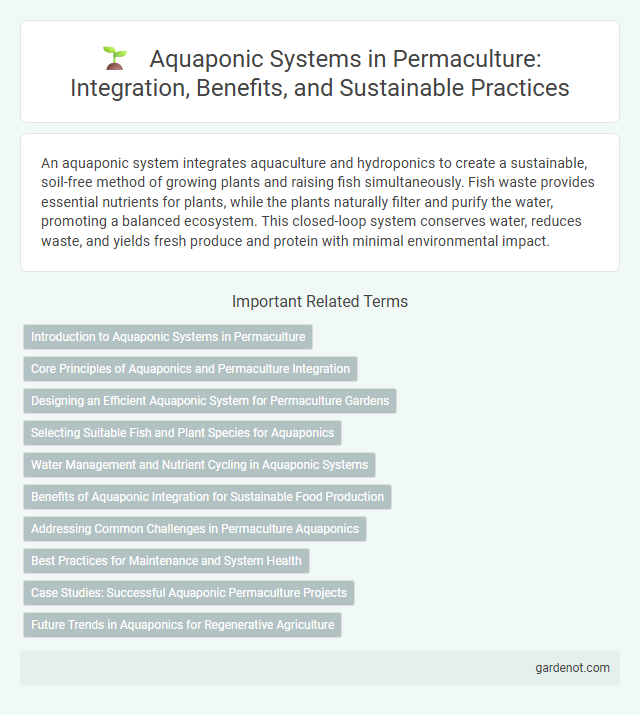An aquaponic system integrates aquaculture and hydroponics to create a sustainable, soil-free method of growing plants and raising fish simultaneously. Fish waste provides essential nutrients for plants, while the plants naturally filter and purify the water, promoting a balanced ecosystem. This closed-loop system conserves water, reduces waste, and yields fresh produce and protein with minimal environmental impact.
Introduction to Aquaponic Systems in Permaculture
Aquaponic systems integrate aquaculture and hydroponics in permaculture, creating a sustainable ecosystem where fish waste provides nutrients for plants, while plants filter water for fish. This symbiotic relationship maximizes resource efficiency, reduces water usage by up to 90% compared to conventional farming, and promotes organic food production. Aquaponics supports diverse crop and fish species, enhancing biodiversity and resilience within permaculture designs.
Core Principles of Aquaponics and Permaculture Integration
Aquaponic systems embody the core principles of permaculture by promoting resource efficiency, closed-loop nutrient cycling, and biodiversity. This integration enhances sustainable food production through symbiotic relationships between aquatic animals and plants, mimicking natural ecosystems. Emphasizing water conservation and waste recycling, aquaponics exemplifies permaculture's holistic approach to resilient and regenerative agriculture.
Designing an Efficient Aquaponic System for Permaculture Gardens
Designing an efficient aquaponic system for permaculture gardens involves integrating fish tanks and grow beds to create a symbiotic environment where fish waste provides nutrients for plants. Key factors include selecting appropriate fish species, optimizing water circulation, and balancing the nutrient levels to promote healthy plant growth and sustainable fish health. Incorporating renewable energy sources and using locally sourced materials further enhances the system's sustainability and energy efficiency.
Selecting Suitable Fish and Plant Species for Aquaponics
Selecting suitable fish and plant species for aquaponics requires consideration of compatibility in temperature, pH, and nutrient requirements. Tilapia, catfish, and trout are popular fish species known for their adaptability in aquaponic systems, while leafy greens such as lettuce, kale, and herbs like basil thrive due to their nutrient uptake efficiency. Balancing species with complementary growth rates optimizes system productivity and sustainability in permaculture practices.
Water Management and Nutrient Cycling in Aquaponic Systems
Aquaponic systems integrate aquaculture and hydroponics to optimize water use by recirculating nutrient-rich water between fish tanks and plant beds, significantly reducing freshwater consumption compared to traditional agriculture. Efficient nutrient cycling occurs as fish waste provides essential nutrients for plant growth, while plants naturally filter and purify the water, creating a sustainable closed-loop system. Proper water management strategies, including monitoring pH, dissolved oxygen, and nutrient levels, are critical for maintaining system balance and maximizing productivity in permaculture designs.
Benefits of Aquaponic Integration for Sustainable Food Production
Aquaponic systems combine aquaculture and hydroponics to create a symbiotic environment that enhances sustainable food production by minimizing water usage and eliminating synthetic fertilizers. This integration improves nutrient cycling, promotes faster plant growth, and supports year-round crop cultivation with reduced environmental impact. Aquaponics reduces waste output from fish farming by converting it into valuable plant nutrients, significantly increasing resource efficiency in permaculture setups.
Addressing Common Challenges in Permaculture Aquaponics
Permaculture aquaponics systems often face challenges such as nutrient imbalance, water quality management, and pest control. Optimizing fish species selection and integrating diverse plant varieties can enhance system resilience and nutrient cycling efficiency. Implementing regular water testing and using organic pest management techniques maintain ecosystem health and productivity.
Best Practices for Maintenance and System Health
Regular monitoring of water quality parameters such as pH, ammonia, nitrite, and nitrate levels ensures a balanced aquaponic system that supports both fish and plant health. Implementing a consistent feeding schedule combined with routine cleaning of filters and pipes prevents system blockages and maintains optimal oxygen levels. Incorporating beneficial bacteria through biofilters enhances nutrient cycling, promoting robust plant growth and a healthy aquatic environment.
Case Studies: Successful Aquaponic Permaculture Projects
Case studies of successful aquaponic permaculture projects demonstrate efficient integration of fish farming and hydroponic plant cultivation, leading to sustainable food production with minimal resource waste. Projects like the Nelson and Pade aquaponics system in Wisconsin showcase high-yield crop growth paired with tilapia farming, reducing water usage by up to 90% compared to traditional agriculture. These systems emphasize closed-loop nutrient cycles and biodiversity, promoting resilient ecosystems that enhance food security and environmental sustainability.
Future Trends in Aquaponics for Regenerative Agriculture
Future trends in aquaponics for regenerative agriculture emphasize closed-loop systems that integrate fish, plants, and beneficial microbes to maximize resource efficiency and minimize environmental impact. Advanced sensor technologies and automated monitoring are improving nutrient cycling and system resilience, enabling scalable urban and rural implementations. Innovations in species diversification and renewable energy integration further support sustainable food production and ecosystem restoration.
Aquaponic system Infographic

 gardenot.com
gardenot.com